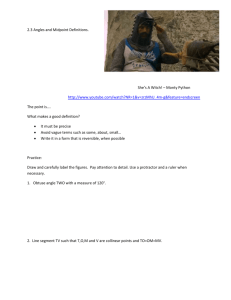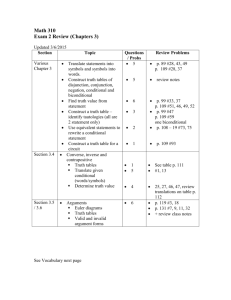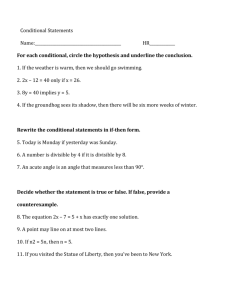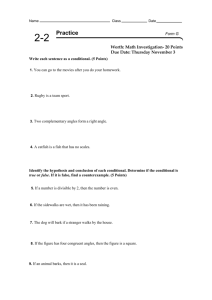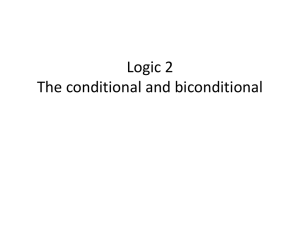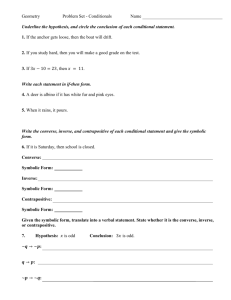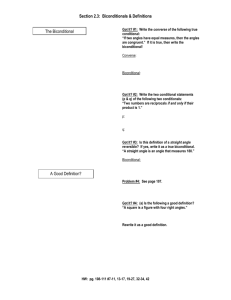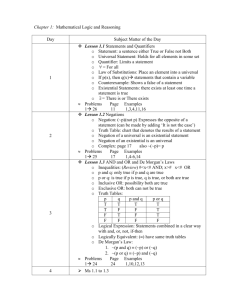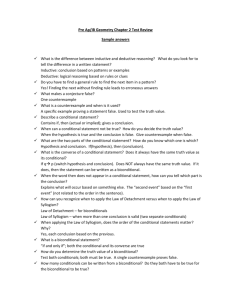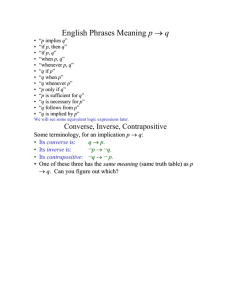Chapter 2 – Reasoning and Proof 2.1 Conditional, Converse
advertisement
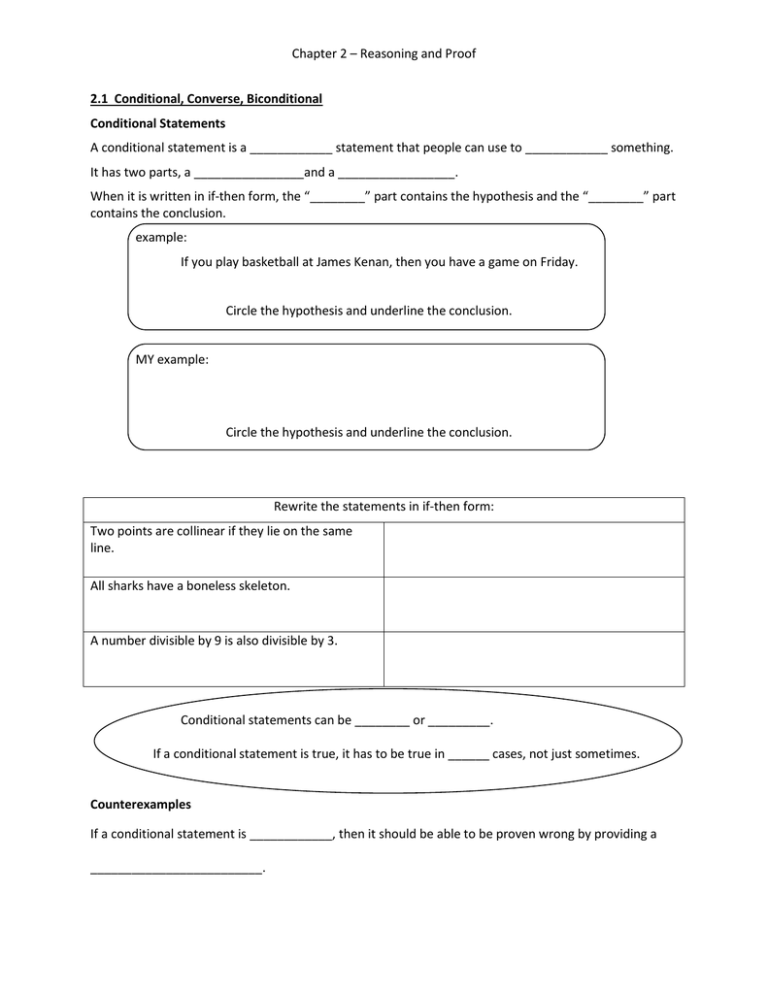
Chapter 2 – Reasoning and Proof 2.1 Conditional, Converse, Biconditional Conditional Statements A conditional statement is a ____________ statement that people can use to ____________ something. It has two parts, a ________________and a _________________. When it is written in if-then form, the “________” part contains the hypothesis and the “________” part contains the conclusion. example: If you play basketball at James Kenan, then you have a game on Friday. Circle the hypothesis and underline the conclusion. MY example: Circle the hypothesis and underline the conclusion. Rewrite the statements in if-then form: Two points are collinear if they lie on the same line. All sharks have a boneless skeleton. A number divisible by 9 is also divisible by 3. Conditional statements can be ________ or _________. If a conditional statement is true, it has to be true in ______ cases, not just sometimes. Counterexamples If a conditional statement is ____________, then it should be able to be proven wrong by providing a _________________________. Chapter 2 – Reasoning and Proof Counterexamples in action… conditional statement – If x2=16, then x=4. conditional statement – If a number is odd, then it is divisible by 3. The conditional statement is false. The conditional statement is _________. counterexample – x = -4 counterexample – _________ Converse The converse of a conditional statement is formed by switching the ______________ and ______________. You leave “if” at the beginning, and “then” in the middle to separate the two parts of the statement. Write the converse of this conditional statement: conditional: If you see lightning, then you hear thunder. converse: Converse statements can be _________ or __________. If a converse is true, it has to be true in _________ cases, not just sometimes. If a converse is false, you then it should be able to be proven wrong by providing a _________________. Biconditional Statements A biconditional statement is a statement that contains the phrase “___________________.” Writing a biconditional statement is equivalent to writing a ____________________ AND its ________________. biconditional statement: We will have practice if and only if it doesn’t rain. Write the biconditional statement as a conditional statements and its converse. conditional statement: converse: Chapter 2 – Reasoning and Proof A biconditional statement can be ________ or __________. If a biconditional statement is true, then the _____________________________ AND the _______________ must be true. If a biconditional statement is false, then either the _________________________ or the _______________ must be false. 2.1 Negation, Inverse, and Contrapositive Negation A statement can be altered by _______________. Negation is the negative or _________________ of a statement. STATEMENT NEGATION m A = 30o A is acute Inverse When you negate the hypothesis and conclusion of a _______________________________, you form the inverse. Write the inverse of each conditional statement. If there is no snow on the ground, then the flowers are in bloom. If m GED = 130o, then it is obtuse. If you are a doctor, then you love science. Contrapositive When you negate the hypothesis and conclusion of a ___________________, you form the contrapositive. Chapter 2 – Reasoning and Proof Write the converse, then contrapositive of each conditional statement. CONDITIONAL STATEMENT CONVERSE CONTRAPOSITIVE If you eat lettuce, then you are skinny. If √100 is z, then z = 10. If an animal is a monkey, then it has a tail. Summarizing Logical Statements conditional statement – ____________ Under these conditions, this will happen. converse – ___________ Converse tried to switch it up by coming out with their “different” looking sneakers. inverse – ____________ The prefix in- means not. contrapositive – _________ AND ___________ Put it all together. equivalent statements – If one of them is true, the other one is __________. If one of them is false, then the other one is _____________. 2.4 Algebraic Proofs Algebraic Properties of Equality ADDITION PROPERTY OF EQUALITY SUBTRACTION PROPERTY OF EQUALITY MULTIPLICATION PROPERTY OF EQUALITY DIVISION PROPERTY OF EQUALITY REFLEXIVE PROPERTY OF EQUALITY SYMMETRIC PROPERTY OF EQUALITY TRANSITIVE PROPERTY OF EQUALITY SUBSTITUTION PROPERTY OF EQUALITY If a = b, then a + c = b + c. If a = b, then a – c = b – c. If a = b, then ac = bc. If a = b and c ≠ 0, then a ÷ c = b ÷ c. For any real number a, a = a. If a = b, then b = a. If a = b and b = c, then a = c. If a = b, then a can be substituted for b in any equation or expression. Chapter 2 – Reasoning and Proof Properties of equality along with other properties from algebra, such as the distributive property, can be used to solve equations. For instance, you can use the subtraction property of equality to solve the equation x + 3 = 7. By subtracting 3 from each side of the equation, you obtain x = 4. Writing Algebraic Proofs The following equation is solved for you, step by step. Use the algebraic properties of equality to write the reasons for step below. STATEMENTS 5x – 18 = 3x + 2 REASONS Given 2x – 18 = 2 2x = 20 x = 10 Try one more… STATEMENTS 55z – 3(9z + 12) = -64 REASONS Given 55z 2x = 20 x = 10 2.3/2.5/2.6 Geometric Proofs Properties of Segment Congruence Chapter 2 – Reasoning and Proof Writing Geometric Proofs Use the diagram and the given information to complete the missing steps and reasons in the proof. given: LK = 5, JK = 5, JK prove: LK JL K JK STATEMENTS REASONS J Given Given LK = JK LK JK JK JL Transitive property of equality L Given Transitive Property of Congruence
